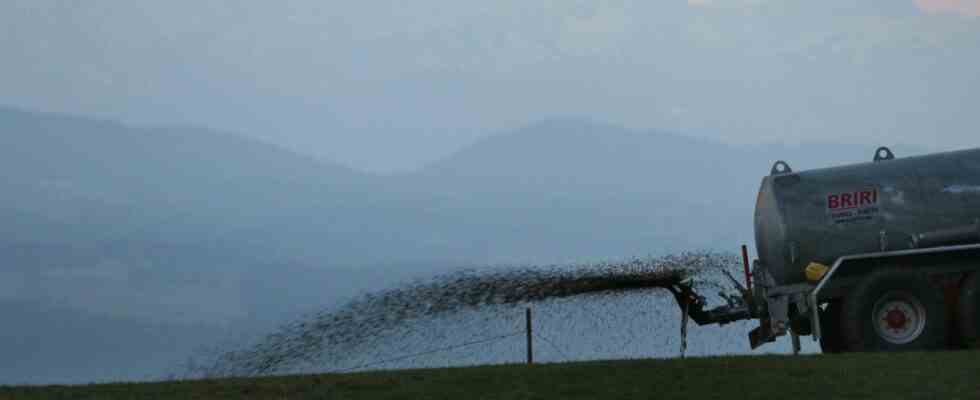It was a bitter argument. But the EU Commission left no doubt that Germany, and thus also Bavaria, must do a lot more to protect the groundwater from contamination from agriculture. Most recently, the commission threatened high penalties. Up to 860,000 euros a day should be due if Germany continues to refuse. Only then did the federal and state governments give in. Even Bavaria bowed – although Minister of Agriculture Michaela Kaniber (CSU) was particularly combative until the end.
This Wednesday Kaniber publishes a map with the new so-called red areas in Bavaria. These are all the regions in which the groundwater is so heavily polluted with the remains of liquid manure and artificial fertilizer that from 2023 onwards farmers will have to comply with stricter regulations when cultivating their land. For the population, municipalities and water suppliers, this is a good day. 85 percent of the drinking water in Bavaria comes from groundwater.
Nevertheless, municipalities and water suppliers are cautious. “I’m curious to see whether the state government will curtsey the farmers again,” says Abensberg Mayor Uwe Brand (CSU). He is also President of the Municipal Council and as such the senior spokesman for more than 2000 small municipal water suppliers. Brandl has been fighting for better protection of the groundwater for years. He is particularly annoyed that Bavaria has significantly fewer and, above all, smaller water protection areas than most other federal states. “It’s not right that the farmers can keep fertilizing their land,” he says. “We need an extended protective backdrop.”
Detlef Fischer from the Association of Bavarian Energy and Water Management (VBEW) is also cautious. “It’s a step in the right direction,” he says. The reason: The areas in which the stricter fertilizer specifications will apply in future cover almost a third more area than their predecessors. But Fischer is not really satisfied. “In order to be able to determine the real pollution of the groundwater, we definitely need many more measuring points,” he says. “There is still a long way to go in Bavaria until there is effective groundwater protection across the board.”
Nitrate is suspected of causing cancer
The dispute revolves around the nitrate. The substance is important for the growth of plants. The farmers apply it to their fields and pastures in the form of manure or artificial fertilizer – in many places in such large quantities that the crops cannot absorb all of it, and instead a large part seeps into the groundwater over time. Especially in Lower Bavaria, northern Swabia and Franconia, the groundwater is already heavily polluted with nitrate. In high concentrations, it is a danger to flora and fauna – and to humans. Nitrate is suspected of causing cancer.
A limit of 50 milligrams of nitrate per liter has been in force throughout the EU for drinking water for years. He is now torn at many groundwater measuring points. Likewise, the precautionary value of 37.5 milligrams per liter, from which the water suppliers have to do something about the nitrate in the groundwater. At more than 27 percent of the measuring points in Bavaria, the nitrate content exceeds the threshold value of 25 milligrams per liter, above which the groundwater is officially classified as “influenced by human activity”.
The dispute with the EU Commission recently revolved around the identification and expansion of the so-called red areas. These are the regions in which the groundwater must be protected against further nitrate inputs. The method for identifying the red areas is complex and a mix of measurements and modelling. The red areas were highly controversial from the start. Because the farmers there are given a whole series of conditions. The most important: You have to reduce fertilization by 20 percent. In addition, they have to observe longer closure periods during the cold season, take nitrogen samples on their fields and the like.
The outcry of the peasants was violent
When it was first designated in 2018, 830,000 hectares of agricultural land across Bavaria were classified as red areas. That is about 25 percent of the agricultural area in Bavaria and, according to experts, is still a fairly accurate reflection of reality. However, the farmers’ outcry was so violent that the state government immediately backtracked and chose a new method of expulsion. On its basis, it classified just under 400,000 hectares (twelve percent) of agricultural land as red areas in 2021. The EU Commission did not play along. It forced another change of method. Now the red areas cover almost 550,000 hectares or 17 percent of the agricultural land.
In the red areas, the pollution of the groundwater with nitrate is particularly high. There are stricter rules for farmers.
(Photo: SZ graphic: Mainka/Bavarian Ministry of Food, Agriculture and Forestry; State Office for the Environment)
This is still significantly less than after the first expulsion. But the farmers and Agriculture Minister Kaniber only accept the new regional setting because the EU Commission would not put up with anything less. “The areas to be re-designated are not set in stone,” says Kaniber, as if to appease the farmers. “We want to update the designation again in 2025.” At the same time, the minister makes no secret of the fact that she is “very disappointed” with the EU Commission.
At the Bavarian Farmers’ Association (BBV), they are keeping quiet, at least to the outside world. “Our farmers stand by sustainable land management that protects the environment and resources,” says Farmer President Günther Felssner. Internally, of course, it is said that there will certainly be farmers in one or the other new red area who will take legal action against the requirements for more groundwater protection.

